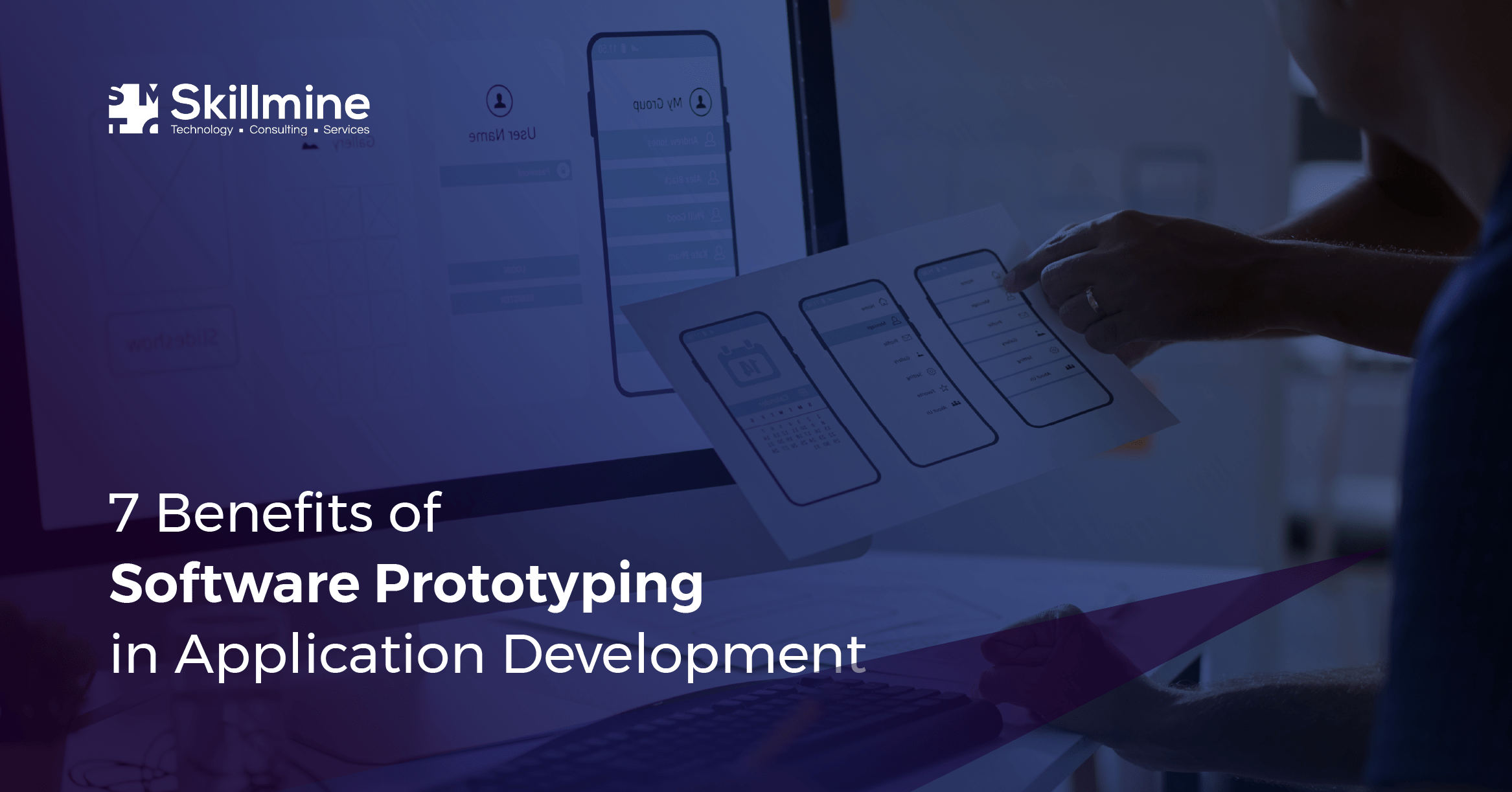Are you looking to take your application development process to the next level? Have you been struggling with finding a cost-effective way of developing successful applications while still staying true to design specifications and meeting user needs? Software prototyping may be the answer. By creating an interactive prototype of your software before investing in costly coding, software prototyping has proved time and again that it can save both time and money for developers. In this blog post, we will deep dive into seven significant benefits of utilizing software prototyping during application development! ( importance of application security )
What is a prototype?
A prototype serves as an initial blueprint or model to assess the feasibility of an idea. It allows for experimentation with new designs or enhancements to current products.
Through prototyping, we can outline operational systems and app development services based on the prototype’s performance, rather than embarking on full-scale design before coding and testing. Incorporating user feedback from the prototype stage helps application development services companies facilitate project optimization prior to development, ultimately reducing production expenses when launching a software project.
Prototyping Planning
During this stage, the team gathers specification requirements from clients, communicates ideas effectively, and identifies any potential project risks. The project team documents client expectations and utilizes this information to craft a plan for a product or an application development service.
Functional Definition
Building upon the client requirements gathered in the previous phase, the team defines the essential functionalities needed to fulfill the client’s objectives. Subsequently, the engineering team devises a roadmap for both prototype and product development.
Prototype Development
This stage involves the creation of a prototype with a primary focus on speed. A clear distinction between prototype and final product is crucial; the former serves as a preliminary model to test diverse ideas. Therefore, functionalities are implemented only to the extent necessary for testing integration and alignment with client needs.
Evaluation and Feedback
The designer presents the prototype to clients for review and feedback. Adjustments are made based on their input, refining the prototype further. If all suggestions and feedback are successfully addressed, the final product will be developed based on the revised prototype.
Popular Prototyping Models
Rapid Throwaway Prototyping: This involves swiftly creating a prototype to aid designers and developers in experimenting with various approaches and gathering feedback from the target audience. Once all stakeholders are satisfied, the prototype serves as a reference but is discarded after completing a project phase, with a new one crafted for subsequent iterations.
Evolutionary Prototyping: Unlike mere simulations, an evolutionary software prototype is an initial version of a product containing basic features and functionality. Additional features are incrementally incorporated based on stakeholder feedback, illustrating the prototype’s evolutionary progression over time.
Incremental Prototyping: Suitable for complex enterprise software with disparate modules, incremental prototyping entails creating independent prototypes for different modules simultaneously. Each prototype is individually assessed and enhanced before being integrated into a cohesive whole, ensuring consistency across the system.
Extreme Prototyping: Commonly employed in web development, extreme prototyping comprises a three-step process:
- Presenting a basic HTML prototype with all existing pages.
- Simulating data processing through a prototype services layer.
- Integrating services into the final prototype.
This method keeps the development team focused on the end product while facilitating swift project iterations.
Faster Development
Prototyping can help speed up the application development process by allowing developers to quickly create and test a working model of the application. According to a study by IBM, software prototyping can help reduce development time by up to 50%. Additionally, a survey by the Standish Group found that projects that used prototyping had a success rate of 82%, compared to a success rate of 55% for projects that did not use prototyping. This suggests that software prototyping can not only speed up development but also improve the likelihood of project success.
Furthermore, another study by the University of Maryland found that software prototyping can help reduce the number of errors in the final application. The study showed that prototypes that were reviewed and tested by users had 33% fewer errors than those that were not reviewed and tested. Overall, the benefits of faster development through software prototyping can be significant, with reduced development time, increased project success rates, and fewer errors in the final application.
Better Collaboration
The prototype provides a visual representation of the application that allows team members to better understand the requirements and expectations. This can lead to clearer communication and fewer misunderstandings, leading to better collaboration. With a prototype in hand, team members can quickly identify potential issues and concerns, leading to faster problem resolution and more effective collaboration. Prototyping allows stakeholders to see and interact with an application before it is fully developed, providing opportunities for feedback and interaction. This can lead to better collaboration and alignment between team members and stakeholders.
By identifying and fixing potential problems early in the development process, prototyping can help reduce project risk and improve collaboration. An IBM study found that high-collaboration projects are twice as likely to succeed as low-collaboration projects. A Project Management Institute (PMI) report found that projects with good communication and collaboration are 1.5 times more likely to be successful than projects with poor communication and collaboration. These statistics demonstrate the importance of collaboration in software development and its significant impact on project success and team productivity.
More accurate requirements
Software prototyping allows stakeholders to see and interact with an application before it is fully developed, which can help them better understand the project requirements and expectations. With a prototype in hand, stakeholders can quickly identify potential issues and challenges, which can lead to faster problem-solving and improved requirement accuracy. According to a report from the Project Management Institute (PMI), poor requirements management is a leading cause of project failure, and prototyping can help reduce the need for rework and revisions, which can lead to more accurate requirements and a smoother development process. According to a survey by McKinsey & Company, companies that effectively manage requirements are 60% more likely to deliver projects on time and within budget.
Improved User Experience
Software prototyping allows designers and developers to incorporate user needs and preferences into the final product, resulting in an improved user experience. This allows for iterative design, enabling designers to refine the user interface and experience through multiple iterations based on user feedback. According to a report by Forrester Research, companies that invest in user experience see a reduction in development costs by up to 50%, an increase in conversion rates by up to 400%, and a reduction in support costs by up to 50%. A survey by UserTesting found that companies that prioritize user experience see higher customer satisfaction rates, with 73% of customers more likely to recommend a company with a good user experience.
By identifying and addressing potential user experience issues early in the development process, software prototyping can help reduce the need for rework and revisions, leading to a more seamless and cohesive user experience. By providing a visual representation of the application, prototyping allows designers to identify and address usability issues early in the development process, resulting in a more intuitive and user-friendly product.
Reduced Costs
Software prototyping allows stakeholders to identify and address potential issues early in the development process, which can save time and money later on. By providing a visual representation of the application, prototyping can help speed up decision-making and development, reducing the time and cost associated with extended development cycles. According to a report by the Standish Group, projects that go over budget do so by an average of 56%. Cost overruns can be attributed to poor requirements gathering, analysis, and documentation. According to a survey by McKinsey & Company, companies that effectively manage requirements are 25% more likely to stay within budget than those that do not. Prototyping allows for iterative feedback and collaboration, which can improve team efficiency and reduce the need for expensive project management overhead. By identifying and addressing usability issues early in the development process, prototyping can help reduce the need for customer support, leading to lower support costs.
Enhanced Innovation
Software Prototyping is a great way to explore creative ideas and concepts before they’re actually developed into a real product. It helps to reduce the fear of failure and encourage innovation, which is critical for companies’ success. According to a survey by PwC, 93% of executives believe that innovation is important for their company’s success. By prototyping early in the development process, companies can avoid risks and make more rapid decisions about the product. In addition, software prototyping can help to enhance innovation by encouraging creative exploration, facilitating iterative development, and reducing the fear of failure. This leads to innovative and competitive products and solutions.
Better Risk management
Software Prototyping allows stakeholders to identify and address potential problems early in the development process, which reduces the risk of problems arising later in the project. Prototyping allows for iterative feedback and collaboration, which enables stakeholders to identify and address issues and risks as they arise, reducing the likelihood of problems becoming major risks later in the project.
A study by the Project Management Institute (PMI) found that the average cost of a project failure is $97 million per $1 billion spent, with poor risk management being a significant contributor to project failure. Prototyping can help improve communication between stakeholders, reducing the risk of misunderstandings and miscommunications that can lead to costly errors and delays. By identifying and addressing potential problems and risks early in the development process, prototyping can help reduce the risk of cost overruns and delays.
Final Thoughts
Skillmine Technologies is the perfect partner organization for all of our technology needs. With over ten years of standing in the IT industry and excellent experience in delivering cutting edge Solutions & IT Services and in optimizing business operations, our team know what it takes to be a top player in this market. Skillmine Technologies is ready to completely transform your business operations with its range of technical expertise as well as its commitment to delivering excellence. Looking for a reliable technology partner? Then look no further – Skillmine Technologies are here! Let’s start this journey together and see what we can do for your company. Don’t forget to share your thoughts on the blog in the comment section below!
Looking for expert technology consulting services? Contact us today.





